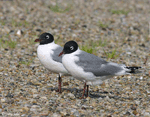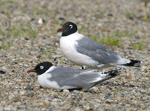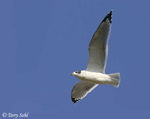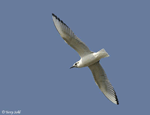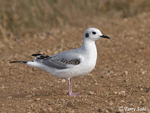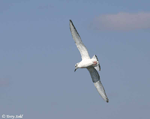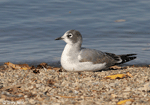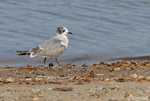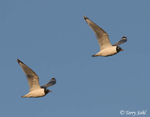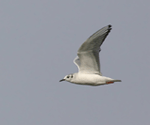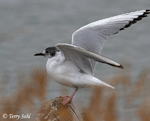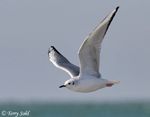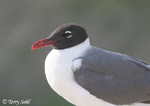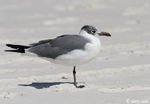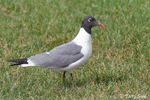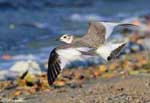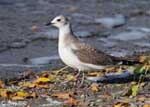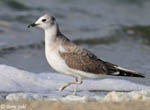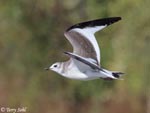NOTE: These five species of gulls all exhibit obvious black
"hoods" in breeding plumage, with much less extensive dark markings on the head
in non-breeding adults, and for juveniles. Of the five species, only two
are commonly found in the state (Franklin's Gull and Bonaparte's Gull).
The two species are relatively easy to differentiate, if given a good look.
Bonaparte's are smaller and more delicate than the Franklin's, have a smaller
bill, and have a distinctive thing white triangle on the outer primaries on the
upper wing. Other species on this page can also be confused with
Franklin's and Bonaparte's Gulls, but they are all very rare visitors to the
state, and do have distinctive wing patterns and other features that make
identification possible.
I have provided the major features that allow the five species to be
differentiated. Note that given the variety of plumages from first-year to
adult birds, the identification keys listed below are not all-inclusive.
However, the features listed below should allow you to safely differentiate
these species. Note I do have photos for some species of both breeding
plumage birds, and juveniles or non-breeding adults (bottom of page). |
|
Franklin's Gull |
|
Bonaparte's Gull |
|
Larus pipixcan |
|
Larus philadelphia |
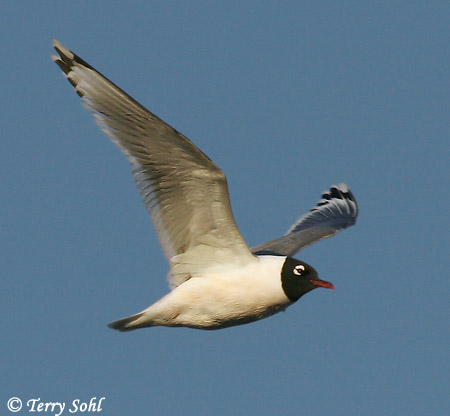
|
|
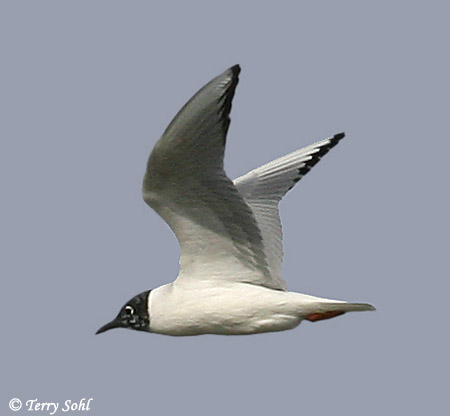
|
|
Height: 14-15 inches |
|
Height: 13-14 inches (noticeably smaller than Franklin's or
Laughing Gull) |
|
Wingspan: 36 inches |
Wingspan: 33 inches |
|
Bill: Deep reddish in breeding plumage, black in other seasons |
Bill: Thin dark bill. |
|
Legs: Reddish black in mature bird, black for juveniles |
Legs: Light pink legs, much different than Franklin's Gull. |
|
Wings: Clean white underwing, black spots on tips.
Upperside gray with white band on back of wing, and next to black tips. |
Wings: Distinctive thin white triangle on upper-wings' outer
primaries (see photo above). Dark tips on primaries. |
|
Head: Dark hood with broad white eye-arcs in breeding plumage
(see photo above). Significant gray and dark gray/black on immatures and
non-breeding adults. Clean white on back of neck (compare to Laughing
Gull). |
Head: Dark hood in breeding plumage, similar in extent to
Franklin's Gull, but with much less prominent white eye arcs. Non-breeding
and 1st winter birds have mostly white heads, with a dark "ear spot". |
|
South Dakota Status: Common migrant, and the only
"black-hooded" gull to breed in the state (primarily in the northeast). |
South Dakota Status: Common migrant in the eastern part of the
state, casual in the west. |
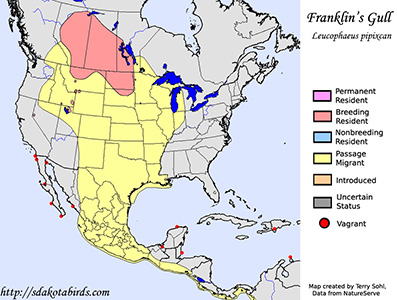 |
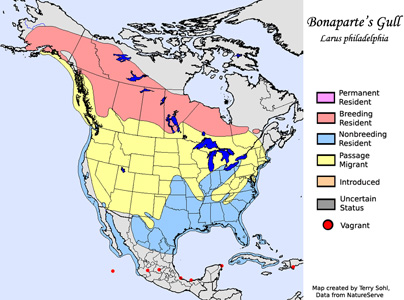 |
|
|
|
|
Laughing Gull |
Sabine's Gull |
|
Larus atricilla |
Xema sabini |
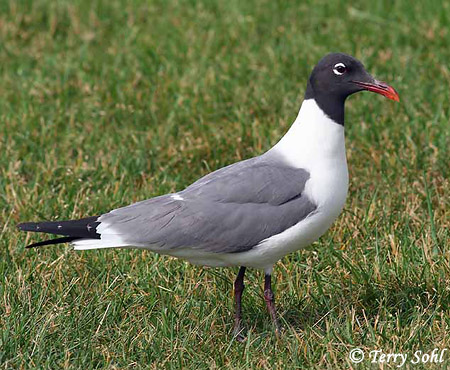 |
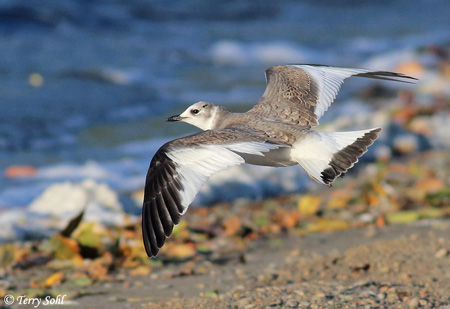 |
|
Height: 16.5 inches |
Height: 13.5 inches |
|
Wingspan: 40 inches |
Wingspan: 33 inches |
|
Bill: Relatively long, dark reddish bill (breeding), dark bill
in other seasons and for juveniles. Bill looks drooped at the tip. |
Bill: Diagnostic in all but first-year birds, black with yellow
tip in breeding plumage. Note bird above is a non-breeding plumage bird. |
|
Legs: Dark reddish-black for adults, black in juveniles. |
Legs: Pinkish in juveniles, darker for adults. |
|
Wings: Relatively long wings compared to others on page.
Gray above with extensive black on wing-tips, thin white trailing band. |
Wings: Diagnostic bold wing pattern, with strong black triangle
on outer primaries, and strong white triangle on inner primaries.
Three-toned look with gray on back and upper wings. |
|
Head: Black in breeding plumage is more extensive than
Franklin's and Bonaparte's. Thinner white eye-arcs than Franklin's, but
still quite noticeable. Non-breeding and juveniles mostly white, with gray
streaking on back of head. |
Head: Dark gray hood in breeding plumage, with black band on
neck. Juveniles and non-breeding adults mostly white, with gray streaking
on back of head (similar to Laughing Gull). |
|
South Dakota Status: Extremely rare visitor to the state, with
only a handful of records. |
South Dakota Status: Rare migrant in the state, primarily in
the fall. Only one spring record of the species, so birds seen are mostly
fall birds in non-breeding plumage, and primarily juveniles. |
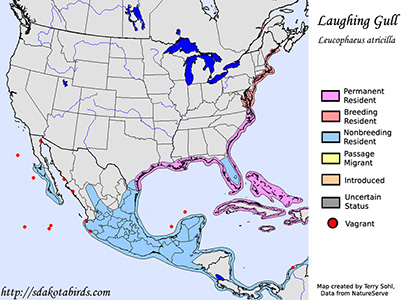 |
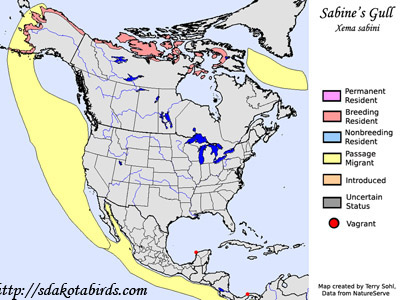 |
|
|
|
|
Little Gull |
|
|
Larus minutus |
|
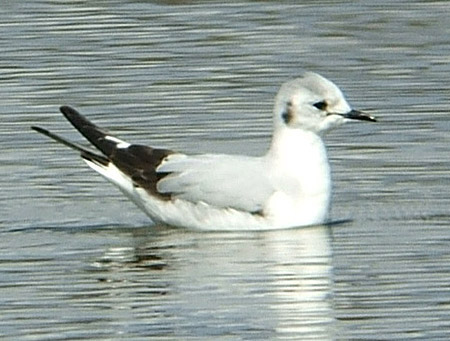 |
|
|
Height: 11 inches |
|
|
Wingspan: 24 inches |
|
|
Bill: Thin, dark bill. |
|
|
Legs: Dark reddish-pink, lighter for first-year birds. |
|
|
Wings: Unique wing pattern, dark underneath with white trailing
edge and tips, light gray above with white trailing edge and tips. |
|
|
Head: Dark hood in breeding plumage, mostly white in
non-breeding adults and juveniles, with a dark "ear-spot", and streaking
or gray on the
back of the crown. |
|
|
South Dakota Status: Very rare visitor to the state, with only
a handful of records. Note photo above is of a first-summer juvenile. |
|
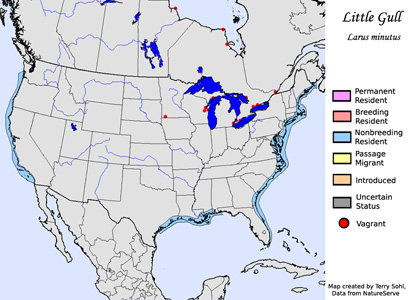 |
|










